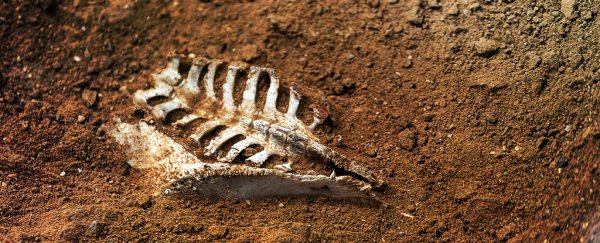Today, the vast majority of scientists agree that humans are causing unprecedented changes to our planet. Yet whether that warrants delineating an entirely new epoch is something geologists continue to disagree on.
Some think the impact of humans is now so great, it exceeds the natural processes of the Holocene, while others argue there's no clear marker in the geological record of the age of humans - the so-called Anthropocene.
Palaeontologists Roy Plotnick and Karen Koy fall in the former category, and they think our fossil record is a dead give-away. In a new paper, the pair argue that in the far future - say, a hundred thousand years from now - fossils of our age will point unmistakably towards humans.
Rather morbidly, they call it the "corpse signal", and it's entirely our fault. Since humans have been on this Earth, the total biomass of wild mammals has fallen by as much as 65 percent; at the same time, the overall biomass of mammals has quadrupled.
The main reason for this tip of the scales is a huge and continuous growth in livestock and humans. This suggests that today, cows, pigs and chickens are far more likely to become "potential fossils".
Throw in domestic pets, like the worldwide dog population of 900 million and the 100 million feral cats, and wild mammals stand even less of a shot.
"The chance of a wild animal becoming part of the fossil record has become very small," says earth and environmental scientist Plotnick from the University of Illinois at Chicago.
"Instead, the future mammal record will be mostly cows, pigs, sheep, goats, dogs, cats, etc., and people themselves."
It's not the first time, this idea has been suggested. In 2018, scientists argued that domestic chickens may act as a marker for the Anthropocene, given their worldwide distribution and their massive population size.
But Plotnick and Koy think this goes far beyond the chicken. After all, there are several other animals like cows, pigs and even humans, that together have almost entirely supplanted wild animals.
What's more, corpses in gravesites and landfills leave behind reasonably complete skeletons that can stay well preserved. Even when livestock are thrown in the dump after being used, solitary bones and cut pieces usually remain.
"These ordered graves are essentially worldwide, so you'll be finding people's remains the same way all over the place," Koy told Science Magazine in an interview.
"I don't know if 'creepy' is quite the right word, but imagine you're an alien from another species and you find this world just covered in these bodies all laid out in a specific way all over its surface; just imagine what that would look like."
Using Michigan as an example - given its potential for creating long-lived fossils - Plotnick and Koy argue that today's vertebrate fossil record would most likely include humans, cattle, pigs, chickens and dogs. In fact, in their analysis, wild deer and other prized hunting animals were the only real exception to that rule.
"In sum," the authors write, "the future vertebrate paleontologist will observe a widespread and distinctive biostratigraphic unit, clearly demarcated from the levels below it."
"Fundamentally, the fossil record of the modern interval will be archeological, not paleontological, and definitely 'Anthropocene'."
Such conclusions are not likely to end the debate over this controversial new epoch, but the "corpse signal" represents an intriguing new marker for research.
The study was published in Anthropocene.
